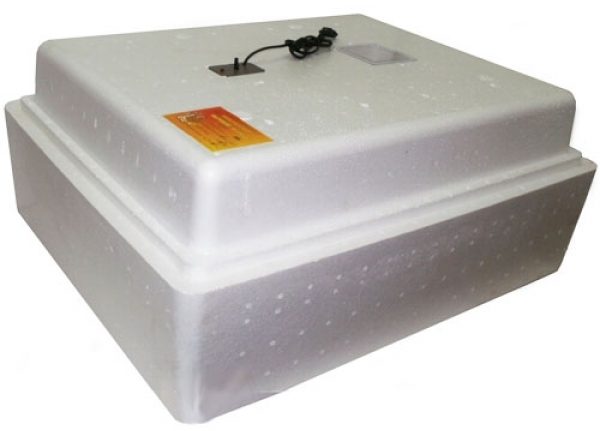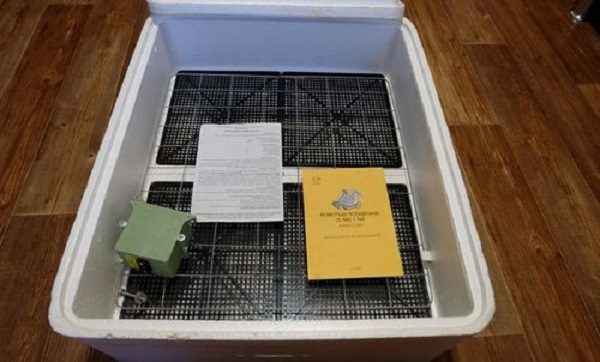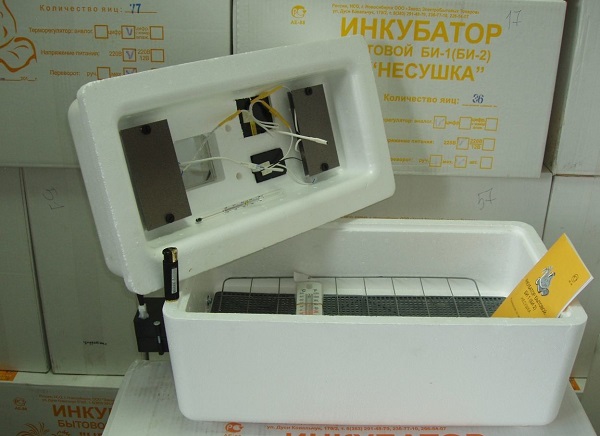Incubator "Lay" BI 1, which is represented on the market in different models, is considered one of the most suitable for home use.
He gained his popularity due to an affordable price, because produced in Russia (Novosibirsk) and small size, which is convenient for small farms.
Table of contents
Modifications: automatic and manual mode
Incubator BI 1 is designed to breed chickens, ducks, geese and quails.Suitable for pheasant eggs, pigeons, parrots.
The case of the device is made of foam plastic, which makes the construction lightweight and provides thermal insulation. The device is equipped with a viewing glass window, at the bottom - a tank with water cells, an evaporator and a sensor, and a thermometer. The latter, depending on the model, may be:
- analog, the temperature setting on which is carried out manually, by turning the knob clockwise to increase and counterclockwise to decrease.
- digital, characteristic of automatic models.
This allows you to make work settings, save them and automatically maintain the set parameters of temperature and humidity.
Device models vary in how they rotate eggs:
- manual;
- auto;
- semi-automatic.
Also have different capacity. The minimum size is calculated on 36 eggs, and the maximum - on 104.
Please note that if necessary, the device can operate for about 20 hours from the battery, which should be purchased in advance.
The clear instruction and the warranty card is attached to each household appliance.

Incubator of a household pile of BI 1
There are two versions of the BI-1 model, which differ in the capacity of the incubation material:
- BI-1-36 (on 36 eggs);
- BI-1-63 (on 63 pieces).
The case of these models is made with durable foam. Heating in BI-1-36 is carried out by incandescent lamps, in BI-1-63 - by special heating elements. To control the temperature there is a thermostat. Egg flipping is automatic. About 20 hours can work on a 12 watt battery. For normal operation of the incubator you need to monitor the temperature and humidity inside.
Incubator layer BI 2
The main difference of domestic incubators "Lay" BI-1 and "Layer" BI-2 in size. Model BI-2 is designed for more incubation material. Like BI-1, BI-2 also has two types:
- BI-2-77 calculated on 77 eggs;
- BI-2A has a capacity 104 pieces.
BI-2-77 is one of the best models in its segment. The device is equipped with a powerful thermostat that maintains the same temperature throughout the incubator. The permissible errors are noted in the instructions, the average may be 0.1 degrees.For large duck and small quail eggs, you can purchase special grids. In the foam case there is a window through which all the pledged material is visible. The incubator consumes 40 watts.
In addition, you can:
BI-2A connects with itself a favorable price and digital devices. The model has a standard case with a viewing window, and additional grilles in the kit. The device is equipped with a digital thermostat and a psychrometer. There is a type of the same model and without these sensors. The device consumes up to 60 watts.
Advantages and disadvantages
Comparing incubators "Layer" with analogues, we can distinguish the following advantages:
- affordable price;
- ease constructions (2-6 kg);
- the good thermal insulation.
These positive qualities are due to the material of the body - foam. However, the disadvantages are the same:
- fragility;
- absorption odor incubation.
Instructions for use incubator layer
Preparation for work
The main stages of preparation for the operation of the incubator are described in the instructions in the sixth section.
- First external inspection instrument and check its configuration.
- At the bottom of the case falls lattice, smooth side up. How this is done is shown in the figure in the instructions.
- On the case of the incubator installs automatic rotation device. All details are described in the annex to the instructions.
- The case is closing lid.
- Connection incubator to a network of 220 V, the lattice will move to the opposite wall.
- Set the average value temperatures on the thermostat. The indicator lights up. Incubator within 10-30 minutes heats upWhen the working temperature has been reached, the indicator will flash.
- 12 V connection thermostat. To do this, the incubator is disconnected from the 220 V network and connected to the battery terminals. The principle of operation of the thermostat 12 V is the same as described above. After the transition to the operating mode, this is signaled by a blinking indicator, the clips are disconnected from the battery terminals.

Egg laying
Before laying the eggs, following the instructions, warm boiled water is poured in and the thermostat is adjusted.It is necessary to reach a temperature of 37.7 degrees. A medical thermometer and an incubator thermometer are used for measurement.
You can use an ovoscope for verification. Bookmark eggs must be stored. no more than 10 days at a temperature not lower than 10 degrees. Otherwise, their incubation qualities are reduced.
Before laying, on eggs with a soft pencil from opposite sides make some marks (for example, "1", "2"). This will facilitate control when turning over.
Reviews
“In principle, the incubator is not bad, lightweight, compact, the electronics work well, you can connect to the battery in case of power outages, but there are also disadvantages. First of all, this is the polyester body itself, although it is an excellent heat insulator, but how to disinfect it after the removal is problematic, uneven heating over the area of the incubator, although the difference is small but influenced by the hatchability percentage. ”
“Incubator budget, 63 eggs, mechanical egg flipping. Easy, foam. But I note that to set the desired temperature is extremely difficult. The thermostat needs to be bought separately. ”
“In principle, there is nothing difficult in the incubator itself; you can assemble it and connect it correctly with the help of the instructions that come with it. It also describes in detail the process of hatching chicks, what temperature is needed, etc. Instructions are required to read! "
Incubator "Layer" is good for home use. Suitable for breeding chicks for your farm, and that for sale. The most popular models with a large capacity. Among the main advantages in the first place available price, then - simplicity of the device and ease of use.

I made sure from my own experience that one cannot save money on a battery. My first incubator was without a battery, and during an emergency power outage, my entire egg laying died. And my mother is convinced that it is necessary not only to turn the eggs, but also to shift them from the edges to the center and back.
We bought bi1 at 36 per unit. The thermostat is not properly set up. Only 13 chicken poults. The rest had developed, but because of the wrong temperature, it froze. Another question, what is the correct order to set up a roll of eggs?